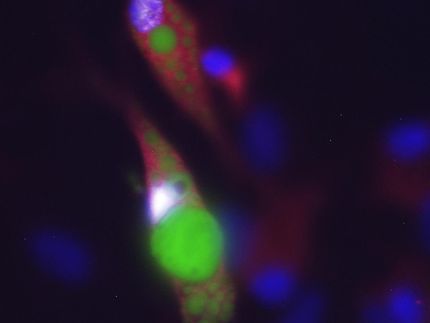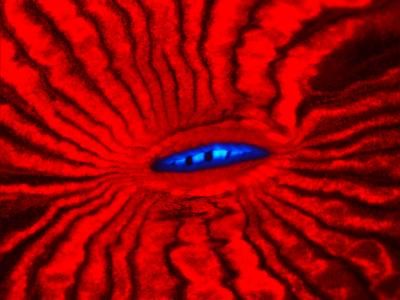Researchers find that one type of stem cell creates a niche for another type in bone marrow
Understanding how blood stem cells are maintained within the niche offers new opportunities to exploit them therapeutically
Hematopoietic stem cells (HSCs) have two unique abilities that are prized by medical researchers: to self-renew and to develop into any kind of blood cell, which enables them to replenish the entire blood and immune system. Scientists have traced these qualities to a distinct locale or niche within the bone marrow that HSCs home in on, but the identity and function of the niche-forming constituents have not been clearly defined.
Now, the precise source of HSC maintenance and regulation within the bone marrow has been discovered by Cold Spring Harbor Laboratory (CSHL) researchers and members of a multi-institutional team. In a study in Nature, the collaborators report that the HSCs retain their unique features in response to signals from another stem cell population, the mesenchymal stem cells (MSCs), which create a supportive bone marrow niche for the HSCs.
"This is the first demonstration that one type of stem cell can regulate another type of stem cells," says CSHL scientist Grigori Enikolopov, Ph.D. "Having a detailed understanding of how HSCs are maintained within the niche microenvironment offers new opportunities to better exploit these cells for therapeutic use."
The path to this discovery originates from Enikolopov's efforts to develop reliable ways of distinguishing stem cells from other cell types. Previously, his group found that various types of stem cells express a protein called nestin. In recent years, they have detected and analyzed stem cell populations located in niches throughout the body using mice genetically engineered such that nestin-expressing cells also produce a fluorescent marker, making it possible to visually track these cells.
One location where the CSHL researchers found these nestin-expressing cells was the bone marrow, but these cells proved to not be HSCs. To find the identity and function of these mystery cells, they teamed up with a multi-institutional group led by Paul Frenette, M.D., of Mount Sinai School of Medicine, and which also included scientists from Harvard Medical School and the Albert Einstein College of Medicine.
Examining bone marrow sections from the nestin-expressing mice and based on the presence of various molecules on the populations of cells found within, the team identified the nestin-expressing cells as MSCs. These cells, which outnumber the HSCs 10:1, were either in direct contact with the HSCs or in clusters around them.
"This close proximity suggested that there might be some kind of molecular signaling or cross-talk going on that might control HSC maintenance," explains Enikolopov, who has been investigating the consequence of this kind of cell-cell dialogue during tissue and organ development. "One hypothesis is that this interaction directs and regulates growth by teaching different types of cells where they ought to locate themselves and what they should do there."
This seems to be the case, at least in the bone marrow, as the collaborators found that altering the numbers of MSCs has a corresponding effect on the numbers of HSCs. Increasing the numbers of MSCs by injecting mice with a growth hormone caused HSCs to double in number. Inhibiting MSC proliferation via infusions of growth-inhibiting proteins, on the other hand, was followed by a dip in HSC numbers.
The collaborators also explored the consequence of completely eradicating bone marrow MSCs using genetic tools developed in Enikolopov's lab. The CSHL scientists created mice in which only nestin-expressing cells — the MSCs — were programmed to carry a receptor for a toxin molecule. Injecting mice with the toxin thus selectively wiped out the MSCs. As a result, the scientists observed a four-fold reduction in the numbers of HSCs in the bone marrow of these mice. In the absence of bone marrow MSCs, large numbers of HSCs injected into the mice also failed to make their way to the bone marrow.
The collaborators found that genetic factors that are essential for HSC maintenance are highly concentrated within the neighboring MSCs. "The expression of these factors are least 500-fold higher in the MSCs than in other bone marrow cells, which shows why HSCs are so highly dependent on the MSCs," says Enikolopov.
"These results are a definitive indication that the MSCs are required for HSC maintenance as well as their homing to the bone marrow," says Tatyana Michurina, Ph.D., a research investigator in Enikolopov's laboratory who is an expert on both MSCs and HSCs. "After studying them as separate entities for years, it was such a surprise to discover that it was the MSCs that helped the HSCs to remain stem-like and primitive."
"These findings suggest that if we can control the niche, we can also manipulate the HSC population within," says Enikolopov. Pharmacological targeting of the niche might help enhance stem cell production for use in regeneration therapies or might help stave off adverse events like leukemia or other disorders where stem cells proliferate out of control.
Original publication: Simon Mendez-Ferrer, Tatyana V. Michurina, Francesca Ferraro, Amin R. Mazloom, Ben D. MacArthur, Sergio A. Lira, David T. Scadden, Avi Ma'ayan, Grigori N. Enikolopov & Paul S. Frenette; "Mesenchymal and haematopoietic stem cells form a unique bone marrow niche"; Nature 2010.























































